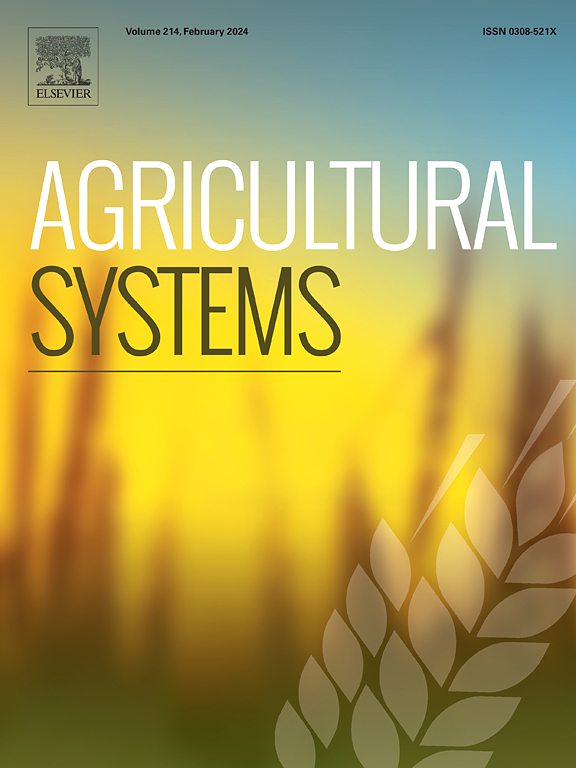Optimization of water and nitrogen measures for maize-soybean intercropping under climate change conditions based on the APSIM model in the Guanzhong plain, China
IF 6.1
1区 农林科学
Q1 AGRICULTURE, MULTIDISCIPLINARY
引用次数: 0
Abstract
CONTEXT
Climate change will significantly impact grain production in the Guanzhong Plain. Maize-soybean intercropping is a stable and efficient cropping system, and optimizing water and nitrogen (N) management strategies for this system under future climate is crucial for sustainable agriculture.
OBJECTIVE
We calibrated the Agricultural Production Systems Simulator (APSIM) model for maize-soybean intercropping under the Guanzhong Plain climate conditions and used the calibrated APSIM model to optimize the water and N strategy of maize-soybean intercropping for high productivity and efficiency under climate change.
METHODS
The APSIM model was calibrated by the data from two growing seasons field experiments. Historical meteorological data from 11 sites was used to evaluate the simulations of 25 Global Climate Models (GCMs) from the Coupled Model Inter-comparison Project phase 6 (CMIP6). The calibrated model was then used to select optimal water and N strategies from 416 setting strategies under future climate scenarios.
RESULTS AND CONCLUSIONS
No irrigation was needed in wet years. In normal years, supplemental irrigation of 50 mm during the maize three-leaf stage (soybean seedling stage) under the Shared Socio-economic Pathways2–4.5 (SSP245) scenario and 30 mm under the Shared Socio-economic Pathways5–8.5 (SSP585) scenario could ensure high yield and water use efficiency (WUE) in the intercropping system. In dry years, under the SSP245 scenario, supplementary irrigation of 70 mm during the maize three-leaf (soybean seedling stage) and tasseling stages (soybean podding stage), and for the SSP585 scenario, supplementary irrigation of 50 mm during the same stages could ensure high productivity and WUE. The optimal N application strategy in dry and normal years under the SSP245 scenario was a basal application of 100 kgN ha−1 for maize and soybean and a topdressing of 80 kgN ha−1 for maize, while in wet years, a basal application of 120 kgN ha−1 and a topdressing of 80 kgN ha−1 was optimal. Under the SSP585 scenario, the optimal N application strategy in dry and normal years was a base application of 100 kgN ha−1 for maize and soybean and a topdressing of 140 kgN ha−1 for maize, and in wet years, a basal application of 120 kgN ha−1 and topdressing of 140 kgN ha−1 was optimal.
SIGNIFICANCE
This study validates APSIM model for the Guanzhong Plain and provides precise water and N management guidelines for maize-soybean intercropping, ensuring food security and efficient resource utilization in future climate conditions.

求助全文
约1分钟内获得全文
求助全文
来源期刊

Agricultural Systems
农林科学-农业综合
CiteScore
13.30
自引率
7.60%
发文量
174
审稿时长
30 days
期刊介绍:
Agricultural Systems is an international journal that deals with interactions - among the components of agricultural systems, among hierarchical levels of agricultural systems, between agricultural and other land use systems, and between agricultural systems and their natural, social and economic environments.
The scope includes the development and application of systems analysis methodologies in the following areas:
Systems approaches in the sustainable intensification of agriculture; pathways for sustainable intensification; crop-livestock integration; farm-level resource allocation; quantification of benefits and trade-offs at farm to landscape levels; integrative, participatory and dynamic modelling approaches for qualitative and quantitative assessments of agricultural systems and decision making;
The interactions between agricultural and non-agricultural landscapes; the multiple services of agricultural systems; food security and the environment;
Global change and adaptation science; transformational adaptations as driven by changes in climate, policy, values and attitudes influencing the design of farming systems;
Development and application of farming systems design tools and methods for impact, scenario and case study analysis; managing the complexities of dynamic agricultural systems; innovation systems and multi stakeholder arrangements that support or promote change and (or) inform policy decisions.
 求助内容:
求助内容: 应助结果提醒方式:
应助结果提醒方式:


